In the fast-paced world of the restaurant industry, providing excellent customer service is essential for attracting and retaining customers. One effective way to enhance customer interaction is by incorporating a chatbot on your restaurant website. Chatbots can handle customer inquiries around the clock, providing quick responses and improving the overall user experience. Here’s a guide on how to effectively incorporate a chatbot into your restaurant website.

Table of Contents
Toggle1. Determine the Purpose of Your Chatbot
Before implementing a chatbot, clearly define its purpose. Consider the common inquiries your restaurant receives, such as:
- Menu Information: Provide details about menu items, ingredients, and specials.
- Reservation Management: Allow customers to make, modify, or cancel reservations.
- Operating Hours: Inform customers about your hours of operation and holiday schedules.
- Location and Contact Information: Share your restaurant’s address, phone number, and directions.
Understanding the primary functions of your chatbot will guide its design and development.
2. Choose the Right Chatbot Platform
Selecting the right chatbot platform is crucial for seamless integration with your website. Here are some popular options to consider:
- Tidio: Offers a user-friendly interface and integrates with various website builders.
- ManyChat: Ideal for restaurants looking to engage customers on social media and websites.
- Chatfuel: Focuses on creating AI-driven chatbots that can handle complex inquiries.
Evaluate each platform’s features, pricing, and compatibility with your website to find the best fit.
3. Design a Conversational Flow
Creating a user-friendly conversational flow is essential for an effective chatbot experience. Consider these tips:
- Use Simple Language: Ensure the chatbot communicates in clear and concise language.
- Anticipate Customer Questions: Develop responses for frequently asked questions to streamline interactions.
- Include Quick Replies: Offer buttons for common inquiries to make navigation easy for users.
A well-structured conversation flow enhances user experience and keeps customers engaged.
4. Personalize Customer Interactions
Personalization can significantly improve customer satisfaction. Use customer data to tailor interactions, such as:
- Greeting Customers by Name: If customers have provided their names, addressing them directly can create a welcoming atmosphere.
- Recommending Menu Items: Based on customer preferences or previous interactions, the chatbot can suggest dishes or specials.
- Collecting Feedback: Encourage customers to share their experiences, allowing you to improve service and offerings.
Personalized interactions can make customers feel valued and enhance their overall experience.
5. Integrate with Reservation Systems
If your restaurant uses a reservation system, integrate it with your chatbot to streamline the booking process. This allows customers to check availability, make reservations, and receive confirmation directly through the chatbot, enhancing convenience.
6. Monitor and Optimize Performance
After launching your chatbot, continuously monitor its performance to ensure effectiveness. Utilize analytics tools to track:
- Response Times: Measure how quickly the chatbot responds to inquiries.
- Customer Satisfaction: Gather feedback from users to identify areas for improvement.
- Common Questions: Analyze frequently asked questions to refine the chatbot’s responses and expand its knowledge base.
Regular monitoring allows you to optimize the chatbot and improve customer interactions over time.
7. Provide an Option to Connect with Staff
While chatbots can handle many inquiries, it’s essential to offer customers an option to connect with a human staff member for more complex issues. Include a “Talk to a Human” button for situations where personalized assistance is needed, ensuring customers feel supported throughout their experience.
8. Promote Your Chatbot
Once your chatbot is live, promote its capabilities to your customers. Mention it on your website, social media platforms, and in email newsletters. Highlight how the chatbot can assist customers, emphasizing the convenience it offers.
Conclusion
Incorporating a chatbot on your restaurant website can significantly enhance customer service by providing quick, efficient responses to inquiries. By carefully defining the chatbot’s purpose, choosing the right platform, and designing a user-friendly conversational flow, you can create a valuable tool that improves customer interactions. Regular monitoring and optimization will ensure that your chatbot continues to meet customer needs effectively. Embrace this technology to streamline operations, enhance customer satisfaction, and ultimately drive more business to your restaurant!


No responses yet